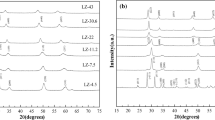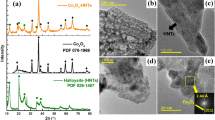Abstract
UV Raman, TG-MS (TPO) and nitrogen physisorption characterization were used to characterize deactivated Mo/HZSM-5 catalysts from coupling reaction of methane CO2 autothermal reforming (MCAR) and methane dehydroaromatization (MDA). The results show that MCAR/MDA maintains the Mo-oxo species throughout the process, reducing the maximum C6H6 yield, but extending the reaction life by at least 4 time. As O/CH4 increases, MCAR/MDA changes from oxygen-deficient to oxygen-rich state. For MCAR/MDA under oxygen-deficient condition, O2 can only delay the accumulation of aromatics. Grown of coke on Brӧnsted acid eventually leads to complete blockage of the micropores of the catalyst. Slowly deposited graphite coke in MCAR/MDA extended the critical time by nearly 4 times. For MCAR/MDA under oxygen-rich condition, a 70% C6H6 selectivity was maintained throughout the process. After 3700 min of operation, the remaining micropore volume and micropore surface of the deactivated catalyst remained above 1/3. The timely removal of graphite coke at the pore mouth by the MCAR/MDA reaction under oxygen-rich conditions can eliminate the limitation of C6H6 diffusion, thereby effectively preventing the acceleration of the coke deposit micropores which cause the MDA reaction to be rapidly deactivated.
Graphic Abstract












Similar content being viewed by others

References
Schwach P, Pan X, Bao X (2017) Direct conversion of methane to value-added chemicals over heterogeneous catalysts: challenges and prospects. Chem Rev 117(13):8497–8520
Mishra S, Balyan S, Pant KK, Haider MA (2017) Non-oxidative conversion of methane into higher hydrocarbons over Mo/MCM-22 catalyst. J Chem Sci 129(11):1705–1711
Spivey JJ, Hutchings G (2014) Catalytic aromatization of methane. Chem Soc Rev 43(3):792–803
Wang LS, Tao LX, Xie MS, Xu GF, Huang JS, Xu YD (1993) Dehydrogenation and aromatization of methane under nonoxidizing conditions. Catal Lett 21(1–2):35–41
Xu YD, Bao XH, Lin LW (2003) Direct conversion of methane under nonoxidative conditions. J Catal 216(1–2):386–395
Liu ST, Wang L, Ohnishi R, Ichikawa M (1999) Bifunctional catalysis of Mo/HZSM-5 in the dehydroaromatization of methane to benzene and naphthalene XAFS/TG/DTA/MASS/FTIR characterization and supporting effects. J Catal 181(2):175–188
Tessonnier JP, Louis B, Walspurger S, Sommer J, Ledoux MJ, Pham-Huu C (2006) Quantitative measurement of the Bronsted acid sites in solid acids: toward a single-site design of Mo-modified ZSM-5 zeolite. J Phys Chem B 110(21):10390–10395
Liu HM, Shen WJ, Bao XH, Xu YD (2005) Methane dehydroaromatization over Mo/HZSM-5 catalysts: the reactivity of MoCx species formed from MoOx associated and non-associated with Bronsted acid sites. Appl Catal A 295(1):79–88
Liu ST, Dong Q, Ohnishi R, Ichikawa M (1998) Unique promotion effect of CO and CO2 on the catalytic stability for benzene and naphthalene production from methane on Mo/HZSM-5 catalysts. Chem Commun 11:1217–1218
Ohnishi R, Liu ST, Dong Q, Wang L, Ichikawa M (1999) Catalytic dehydrocondensation of methane with CO and CO2 toward benzene and naphthalene on Mo/HZSM-5 and Fe/Co-modified Mo/HZSM-5. J Catal 182(1):92–103
Liu Z, Nutt MA, Iglesia E (2002) The effects of CO2, CO and H2 co-reactants on methane reactions catalyzed by Mo/H-ZSM-5. Catal Lett 81(3–4):271–279
Tan PL, Wong KW, Au CT, Lai SY (2003) Effects of Co-fed O2 and CO2 on the deactivation of Mo/HZSM-5 for methane aromatization. Appl Catal A 253(1):305–316
Yuan SD, Li J, Hao ZX, Feng ZC, Xin Q, Ying PL et al (1999) The effect of oxygen on the aromatization of methane over the Mo/HZSM-5 catalyst. Catal Lett 63(1–2):73–77
Lacheen HS, Iglesia E (2005) Stability, structure, and oxidation state of Mo/H-ZSM-5 catalysts during reactions of CH4 and CH4-CO2 mixtures. J Catal 230(1):173–185
Yao SD, Gu LJ, Sun CY, Li J, Shen WJ (2009) Combined methane CO2 reforming and dehydroaromatization for enhancing the catalyst stability. Ind Eng Chem Res 48(2):713–718
Yao SD, Sun CY, Li J, Gu LJ, Shen WJ (2009) Reaction coupling of methane steam reforming and methane dehydroaromatization for improving durability of Mo/MCM-49 catalyst. Chin J Catal 30(10):1022–1028
Kosinov N, Coumans F, Uslamin E, Kapteijn F, Hensen EJM (2016) Selective coke combustion by oxygen pulsing during Mo/ZSM-5-catalyzed methane dehydroaromatization. Angew Chem Int Edit 55(48):15086–15090
Lacheen HS, Iglesia E (2005) Isothermal activation of Mo2O52+-ZSM-5 precursors during methane reactions: effects of reaction products on structural evolution and catalytic properties. Phys Chem Chem Phys 7(3):538–547
Kosinov N, Uslamin EA, Coumans FJAG, Wijpkema ASG, Rohling RY, Hensen EJM (2018) Structure and evolution of confined carbon species during methane dehydroaromatization over Mo/ZSM-5. ACS Catal 8(9):8459–8467
Kosinov N, Uslamin EA, Meng L, Parastaev A, Liu Y, Hensen EJM (2019) Reversible nature of coke formation on Mo/ZSM-5 methane dehydroaromatization catalysts. Angew Chem Int Ed Engl 58(21):7068–7072
Ma D, Wang DZ, Su LL, Shu YY, Xu Y, Bao XH (2002) Carbonaceous deposition on Mo/HMCM-22 catalysts for methane aromatization: a TP technique investigation. J Catal 208(2):260–269
Liu HM, Li T, Tian BL, Xu YD (2001) Study of the carbonaceous deposits formed on a Mo/HZSM-5 catalyst in methane dehydro-aromatization by using TG and temperature-programmed techniques. Appl Catal A 213(1):103–112
Liu HM, Su LL, Wang HX, Shen WJ, Bao XH, Xu YD (2002) The chemical nature of carbonaceous deposits and their role in methane dehydro-aromatization on Mo/MCM-22 catalysts. Appl Catal A 236(1–2):263–280
Sun CY, Fang GZ, Guo XG, Hu YL, Ma SQ, Yang TH et al (2015) Methane dehydroaromatization with periodic CH4-H-2 switch: a promising process for aromatics and hydrogen. J Energy Chem 24(3):257–263
Ma D, Shu YY, Bao XH, Xu YD (2000) Methane dehydro-aromatization under nonoxidative conditions over Mo/HZSM-5 catalysts: EPR study of the Mo species on/in the HZSM-5 zeolite. J Catal 189(2):314–325
Ma D, Shu YY, Cheng MJ, Xu YD, Bao XH (2000) On the induction period of methane aromatization over Mo-based catalysts. J Catal 194(1):105–114
Liu SL, Ohnishi R, Ichikawa M (2003) Promotional role of water added to methane feed on catalytic performance in the methane dehydroaromatization reaction on Mo/HZSM-5 catalyst. J Catal 220(1):57–65
Song Y, Xu YB, Suzuki Y, Nakagome H, Zhang ZG (2014) A clue to exploration of the pathway of coke formation on Mo/HZSM-5 catalyst in the non-oxidative methane dehydroaromatization at 1073 K. Appl Catal A 482:387–396
Song Y, Xu YB, Suzuki Y, Nakagome H, Ma XX, Zhang ZG (2015) The distribution of coke formed over a multilayer Mo/HZSM-5 fixed bed in H2 co-fed methane aromatization at 1073 K: exploration of the coking pathway. J Catal 330:261–272
Tempelman CHL, Hensen EJM (2015) On the deactivation of Mo/HZSM-5 in the methane dehydroaromatization reaction. Appl Catal B 176:731–739
Ferrari AC, Basko DM (2013) Raman spectroscopy as a versatile tool for studying the properties of graphene. Nat Nanotechnol 8(4):235–246
Reich S, Thomsen C (1824) Raman spectroscopy of graphite. Philos Trans A 2004(362):2271–2288
Ferrari AC, Meyer JC, Scardaci V, Casiraghi C, Lazzeri M, Mauri F et al (2006) Raman spectrum of graphene and graphene layers. Phys Rev Lett 97(18):187401(1)-(4)
Lee EL, Wachs IE (2007) In situ spectroscopic investigation of the molecular and electronic structures of SiO2 supported surface metal oxides. J Phys Chem C 111:14410–14425
Gao J, Zheng Y, Jehng J-M, Tang Y, Wachs IE, Podkolzin SG (2015) Identification of molybdenum oxide nanostructures on zeolites for natural gas. Science 348(6235):686–690
Agote-Aran M, Kroner AB, Islam HU, Slawinski WA, Wragg DS, Lezcano-Gonzalez I et al (2019) Determination of molybdenum species evolution during non-oxidative dehydroaromatization of methane and its implications for catalytic performance. Chemcatchem 11(1):473–480
Vollmer I, van der Linden B, Ould-Chikh S, Aguilar-Tapia A, Yarulina I, Abou-Hamad E et al (2018) On the dynamic nature of Mo sites for methane dehydroaromatization. Chem Sci 9(21):4801–4807
Zhu PF, Yang GH, Sun J, Fan RG, Zhang PP, Yoneyama Y et al (2017) A hollow Mo/HZSM-5 zeolite capsule catalyst: preparation and enhanced catalytic properties in methane dehydroaromatization. J Mater Chem A 5(18):8599–8607
Huang X, Jiao X, Lin M, Wang K, Jia L, Hou B et al (2018) Coke distribution determines the lifespan of a hollow Mo/HZSM-5 capsule catalyst in CH4 dehydroaromatization. Catal Sci Technol 8(22):5753–5762
Ding WP, Li SZ, Meitzner GD, Iglesia E (2001) Methane conversion to aromatics on Mo/H-ZSM5: structure of molybdenum species in working catalysts. J Phys Chem B 105(2):506–513
Hedlund J, Korelskiy D, Sandström L, Lindmark J (2009) Permporometry analysis of zeolite membranes. J Membr Sci 345:276–287
Lezcano-Gonzalez I, Oord R, Rovezzi M, Glatzel P, Botchway SW, Weckhuysen BM et al (2016) Molybdenum speciation and its impact on catalytic activity during methane dehydroaromatization in zeolite ZSM-5 as revealed by operando X-ray methods. Angew Chem Int Edit 55(17):5215–5219
Kosinov N, Coumans F, Uslamin EA, Wijpkema ASG, Mezari B, Hensen EJM (2017) Methane dehydroaromatization by Mo/HZSM-5: mono- or bifunctional catalysis? ACS Catal 7(1):520–529
Tempelman CHL, Zhu XC, Hensen EJM (2015) Activation of Mo/HZSM-5 for methane aromatization. Chin J Catal 36(6):829–837
Zhao T, Wang H (2011) Methane dehydro-aromatization over Mo/HZSM-5 catalysts in the absence of oxygen: effect of steam-treatment on catalyst stability. J Nat Gas Chem 20(5):547–552
Levenspiel O (1972) Experimental search for a simple rate equation to describe deactivating porous catalyst particles. J Catal 25:265–272
Solymosi F, Cserenyi J, Szoke A, Bansagi T, Oszko A (1997) Aromatization of methane over supported and unsupported Mo-based catalysts. J Catal 165(2):150–161
Weckhuysen BM, Rosynek MP, Lunsford JH (1998) Characterization of surface carbon formed during the conversion of methane to benzene over Mo/H-ZSM-5 catalysts. Catal Lett 52(1–2):31–36
Acknowledgements
This work was supported by the key project of Liaoning Province Natural Science Fund Project (20170540459), the open objects of the major science and technology platform, Liaoning University of Science and Technology (USTLKFZD 201632) and the 47th batch Scientific Research Foundation for the Returned Overseas Chinese Scholars, State Education Ministry of China.
Author information
Authors and Affiliations
Corresponding author
Ethics declarations
Conflict of interest
The authors declare that they do not have any commercial or associative interest that represents a conflict of interest in connection with the work submitted.
Additional information
Publisher's Note
Springer Nature remains neutral with regard to jurisdictional claims in published maps and institutional affiliations.
Rights and permissions
About this article
Cite this article
Chen, X., Dong, Y., Lin, S. et al. Promoting Mechanism of MCAR/MDA Coupling Reaction Under Oxygen-Rich Condition to Avoid Rapid Deactivation of MDA Reaction. Catal Lett 150, 2115–2131 (2020). https://doi.org/10.1007/s10562-020-03114-1
Received:
Accepted:
Published:
Issue Date:
DOI: https://doi.org/10.1007/s10562-020-03114-1



